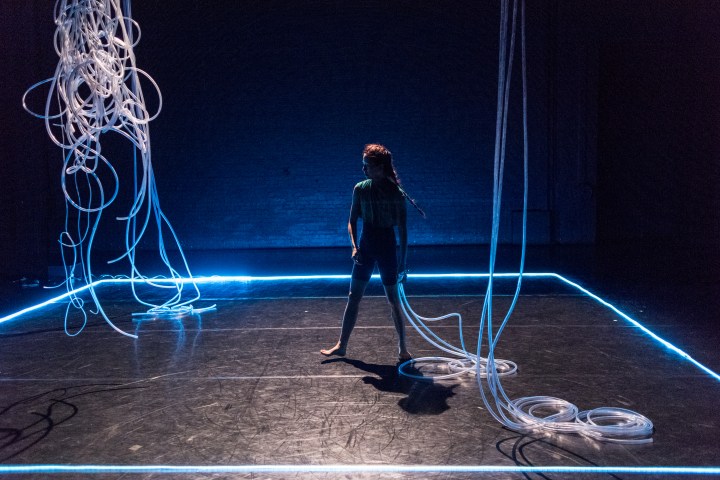Review from: The Cockpit, Voila! Europe festival, London; 8th November 2019
Once upon a time, a curious child was born into a world already peopled with plastic. Thin coiled tubes, hanging from the sky. She was not afraid. She did what children do. She played with the plastic. She discovered what it could do. Because she was a human child, she tried to befriend it. Because she was a human child, she tried to conquer it. The plastic did not make friends. The plastic did not submit. It was plentiful, strong and resilient, and she was only one fragile child.
In a black box theatre space in the West End of London (but not that West End), a circus performer steps into a dark space, cornered on three sides by banks of audience seating, and separated from the central area by a length of cable laid out in a square on the floor. She spots a pair of small, lime-green wellington boots in the shadows. She puts them on and, illuminated with a handheld UV torch that makes them glow out of the dim light, they come to life. Different patterns of steps and shuffles around the perimeter cable animate fleeting characters in my mind. Inside the square, hanging in the dark, thin coiled tubes of transparent plastic wait, inert.
Hazel Lam‘s 50-minute solo creation, Lighthouse, inhabits an odd place between non-verbal children’s theatre and avant-garde performance art. I suppose there’s no reason for the two to be mutually exclusive, and I’ll admit the unusual combination charms me as often as it throws me off-kilter. Hazel moves with the clean, elegant lines of a ballerina while displaying the same innocent playfulness I saw in her portrayal of the Little Girl in Upswing’s Bedtime Stories, occasionally sharing a direct offer of a smile, a conspiratorial eye-widen, or the owchie of a trapped finger, over the separating line between audience and performer.
Her performing partners are less open. The plastic tubes stretch a little, coil and knot at Hazel’s manipulations, but remain aloof and inscrutable. A spray of three, gracefully reaching ceiling to floor; a tangle hanging in the middle of the space; a looped curl secured in the back left corner. Climbed together like a vertical rope, or split and knit into multi-cord arrangements, the plastics slap and crack together. The recorded soundtrack adds creaks of weight-bearing. Small sounds of muffled humour and art gallery murmurs of appreciation come from the rows of audience behind me.
Watery sounds in the pre-recorded soundtrack bubble into a mermaid fantasy. The girl is floating underwater, stretching her arm wavily up towards the surface. Ominous overtones of deep, vibrating notes are drowned out by more optimistic melody. It’s obvious now that her lycra outfit is a swimming costume as she shakes and twitches, desperately reaching upwards.
I watch the precarity of their partnership, plastic and person. A fragile human child trying to control these senseless beasts. I’m waiting to see if the story will end in optimism or disaster. ‘Aren’t we all?’, I think. The mystery is not resolved.




